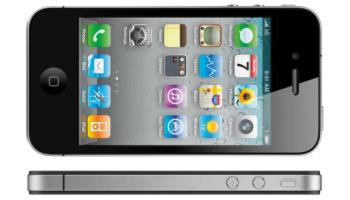UK In First Wave Of iPhone 4 Launch

Apple boss Steve Jobs has taken the stage at the company’s 2010 Worldwide Developers Conference to reveal the much-expected next-generation iPhone
Apple CEO Steve Jobs took to the stage on 7 June at the company’s 2010 Worldwide Developers Conference (WWDC) in San Francisco to announce the much-expected next-generation iPhone.
The device represents Apple’s hopes of staying ahead in the consumer smartphone market, where it finds itself challenged by not only traditional competitors such as RIM’s BlackBerry franchise, but also the rapidly growing family of Google Android devices.
After updating the keynote audience on iPad sales (2 million and counting), tweaks to its iBooks feature, and Netflix for the iPhone, the turtleneck-clad Jobs then moved to what many considered the day’s main event: breaking down the features of the new smartphone, dubbed iPhone 4. Those hoping for a radical revamp to the device were likely not disappointed, and those who followed news of the leaked iPhone prototypes earlier this year were definitely not surprised, by the new iPhone’s features: a larger battery, a thinner body, a proprietary A4 processor under the hood, a front-facing camera for video conferencing, and a 5-megapixel camera paired with a rear illuminated sensor.
Biggest Leap Since iPhone
Jobs termed the new smartphone “the biggest leap since the original iPhone,” according to a live transcript of the event, adding: “This is beyond doubt one of the most precise, beautiful things we’ve ever done.” The larger battery supposedly offers seven hours of talk time, 300 hours of standby, 40 hours of music, 10 hours of video, six hours of Web browsing with a 3G connection and 10 hours’ browsing with WiFi.
 For users, the device seems to pack a lot of visual firepower. The iPhone 4’s camera can shoot 30-frames-per-second HD video at 720p, and the screen boasts a resolution of 326 pixels per inch—the latter a feature called Retina Display. “Once you used a Retina Display, you can’t go back,” Jobs reportedly joked, before comparing the new device’s screen clarity to that of the iPhone 3GS.
For users, the device seems to pack a lot of visual firepower. The iPhone 4’s camera can shoot 30-frames-per-second HD video at 720p, and the screen boasts a resolution of 326 pixels per inch—the latter a feature called Retina Display. “Once you used a Retina Display, you can’t go back,” Jobs reportedly joked, before comparing the new device’s screen clarity to that of the iPhone 3GS.
The iPhone 4 also includes a built-in 3-axis gyroscope, for refined location data. While gyroscopes have commonly been used in a number of non-consumer devices such as ballistic missiles, their integration into smartphones potentially opens the door to a number of applications and features, including boosted camera stabilization, gesture-based user interfaces and dead-reckoning aids for GPS.
Jobs revealed a new feature called FaceTime, which lets users make video calls via WiFi. While using FaceTime, the screen can be tilted into landscape mode, to better frame a pair of people at one end of a particular call; Jobs suggested that Apple was in talks with carriers about offering a 3G-enabled version.
In UK from 24 June
The iPhone 4 will be available in five countries including the UK – in either white or black – starting on 24 June. The 16GB version will retail in the US for $199, and the 32GB version for $299, with a two-year contract through AT&T. International pricing has not been announced.
The iPhone 4’s operating system, previously dubbed “iPhone OS 4,” received a name change: iOS4, with 1500 new APIs and user features such as multitasking. The platform’s other notable element, “iAd,” will allow developers to deliver mobile advertisements within apps themselves.
“There is definitely a market for your applications,” Jobs told the audience, which featured developers attending the WWDC for technical sessions in creating programs for the iPhone, iPad and Mac franchise.
Despite the high-profile slickness of Apple’s presentation, a few snafus did occur. When The New York Times app failed to load during a Web-browsing demonstration, reportedly because too many devices were using the local wireless network, Jobs reportedly voiced his displeasure: “Well, Jeez, I don’t like this.”
“Verizon!” someone in the crowd yelled, according to USA Today. But given that Jobs was trying to access a WiFi network, as opposed to 3G, the app’s failure was one thing that couldn’t be laid at the feet of Apple’s exclusive carrier in the United States.